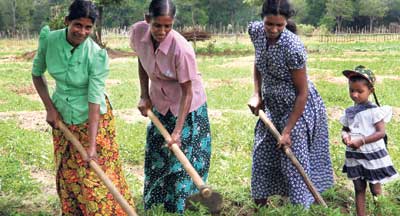
Lankan farmers add spice to Slowfood movement
Sri Lankan spices are slowly spicing up the European Slowfood movement. The hottest item joining the Slowfood movement from Sri Lanka is the sizzling Sri Lankan chilli. Organically grown chillies from Sri Lanka are entering major European markets like Italy, Germany and France. These exports are putting money into the pockets of rural farming communities in Sri Lanka. The Slowfood movement, although almost unknown in Sri Lanka, is a growing global phenomenon. In the face of expanding fast food culture and mass production, the Slowfood movement is trying to safeguard traditional foods and small farmers all over the world. Sri Lankan small farmers are linking up with the movement through local Non Governmental Organisations (NGOs). Slow is better “Slowfood began in Italy 20 years ago to give back dignity to farmers,” said Saldo, speaking to journalists during a recent International Labour Organisation media training course. The movement supports food production in the traditional fashion, by small producers, as opposed to chemical based, mass production. Slowfood says this is not just healthier eating, but is also socially and environmentally more sustainable. Because mass production focuses only on a limited range of commercially viable foods, thousands of indigenous plants, animals and food items are being driven to extinction all over the world. Slowfood says traditional foods must be allowed to coexist with commercial outputs, to preserve cultural diversity. “The survival of the food community of the southern part of the world is vital to contrast forces of gloabalisation. Only if they survive can we save local cultures,” said Saldo. Looking after domestic farmers to ensure domestic food production is also seen as economically healthier. “Some say it is better to import food because prices are lower. But producers in many of the countries that are exporting food, are subsidised. Sooner or later the subsidies and export aid will be removed. Then you will have to pay higher prices to import the same food and it will not be produced locally as well. So you will be trapped,” explained Saldo. But small producers cannot compete on price, with mass production. So Slowfood maintains that people must be educated, to choose to pay higher prices, for socially, physically and environmentally healthier food production.“The first thing was to educate consumers. We also convinced consumers that higher quality products must be paid more, than industrial products,” said Saldo. Consumers in the west are now actively making this choice and the demand for cleaner, healthier foods, is growing. Slowfood network The Slowfood Foundation itself does not buy or sell goods. It simply puts at the disposal of farmers a distribution network to access western markets. Sri Lankan NGOs for instance, are using the Fairtrade shop network that is linked with the Slowfood movement, to sell to western consumers. Slowfood also educates producers on how to improve production techniques. Foods that enter the Slowfood network do not have to be organic. They are generally traditional foods, produced through traditional methods that use fewer chemicals. “From all over the world we have looked for products that have their own identity and are linked to local communities,” said Serena Milano from the Slowfood Foundation. Sri Lanka in Slowfood We also use the Fairtrade shops to sell in other countries as well,” said the executive director of PODIE, Tyrell Fernando. Local spices are sent to Western Europe, Scandinavia, Australia, and New Zealand. PODIE exported around 15-20 tonnes of spices in 2006 and the demand is growing. In 2006 total exports brought in Rs 45 million. Around 1,500 farmer families benefit from the exports. PODIE says farmers earn more when using the Slowfood network because end-retail prices are higher. “We purchase from the farmers by paying them 25% - 40% more than market rates. Our prices to end consumers are also about 30% higher,” said Fernando. Organically cultivated local chillies are also a hot favourite in Europe and other western countries. “Organic chilli cultivation is very difficult because the chilli plant is very susceptible to pest attacks. But we have been very successful in this. We export around 2.5 tonnes of organic chilli per year to Italy, France, Germany, Austria, Sweden, Australia and New Zealand,” said Fernando. The Siyath Foundation, another local NGO, is trying to export organically cultivated indigenous rice varieties into Europe and the US. “We did a test export to Italy, Germany and the US. The results were very good. We can access these markets through Fairtrade shops. In Italy alone we sold around 7,000 kgs as a sample only. But there is not enough production of these rice varieties,” said Indika de Costa, a director at the Siyath Foundation. Given the rich variety of traditional foods in the island, these NGOs say Sri Lanka has great potential in a growing Slowfood world.
|
|
||||||
|
||||||
| || Front
Page | News
| Editorial
| Columns
| Sports
| Plus
| Financial
Times | International
| Mirror
| TV
Times | Funday Times || |
| |
Reproduction of articles permitted when used without any alterations to contents and a link to the source page.
|
© Copyright
2008 | Wijeya
Newspapers Ltd.Colombo. Sri Lanka. All Rights Reserved. |
